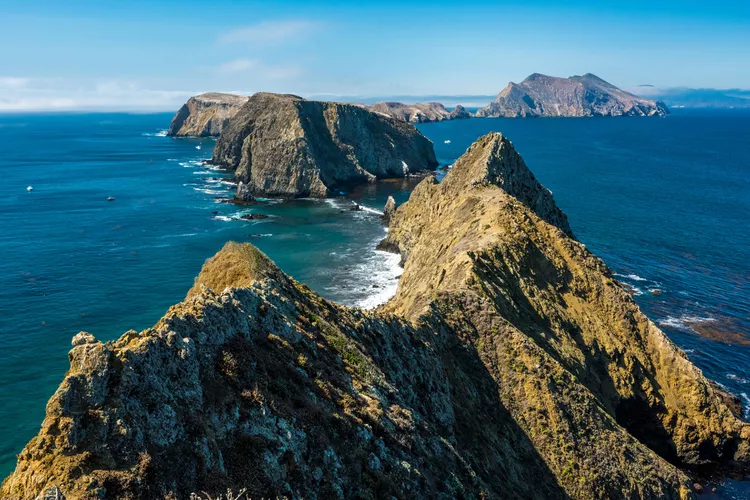Summary
From biggest to lowest to tallest, these California national parks have plenty of superlatives.
California may not be the largest state in the U.S. (it’s No. 3), but it’s certainly one of the most geographically diverse. Over the course of nearly 900 miles, the elongated state goes from lush, rugged coastline to dry desert near the U.S.-Mexico border. It’s a state that has it all: mountains, beaches, vineyards, deserts, and forests.
Thanks to its varied climate and impressive size (it’s three times the size of Greece), California is home to a whopping nine national parks — more than any other state. These parks protect the state’s most precious resources, including the sky-high dunes of Death Valley and the towering sequoia trees of Sequoia and Kings Canyon.
To guide your adventure through the wondrous Golden State, here are the best national parks in California — and what makes each one worth a visit.
Death Valley National Park

Death Valley National Park is the largest national park in California — and the continental U.S. (topped in size only by Gates of the Arctic National Park and Preserve in Alaska). Sprawling across 3.3 million acres are never-ending salt flats, mountain-sized sand dunes, and colorful Mars-like canyons. Death Valley is home to the lowest point in North America and holds the title as the hottest and driest place in America (summer temps exceed 120 degrees). However, if you like extreme terrain, be ready to fall in love with Death Valley, where every view feels practically unfathomable.
Joshua Tree National Park

The twisted silhouette of the Joshua tree is likely what comes to mind when you think of this park; however, there is so much more to Joshua Tree National Park than its flora. The park sits at the point where the high Mojave Desert meets the low Colorado Desert, resulting in stark desert landscapes dotted with rugged rock formations. At night, the skies are clear and dark — providing stellar stargazing — while the sun shines high and strong during the day. Joshua Tree is a beautiful place to hike — just make sure to pack plenty of water.
Channel Islands National Park
California is not a state known for its large swaths of undeveloped land — especially along the coast. This is part of what makes Channel Islands National Park so special. The park encompasses five islands off the Southern California coast, providing a true escape from civilization. Nicknamed the “Galapagos of North America,” the Channel Islands are home to a handful of endemic plants and plentiful wildlife, while being void of lodging, stores, and restaurants. Sea caves, seals, nesting seabirds, and hiking and camping make this national park the perfect getaway from it all.
Yosemite National Park

Yosemite is the state’s most-visited national park, with 3.3 million visitors in 2021. Consequently, while you may need to get strategic about when to go to avoid the crowds, Yosemite is popular for a reason. The monstrous granite cliffs of El Capitan and Half Dome tower over ancient sequoia trees, while cascading waterfalls are the cherry on top. There’s a reason why Ansel Adams couldn’t get enough of the landscape, which is also a UNESCO World Heritage site.
Pinnacles National Park

Pinnacles National Park, which was only granted national park status in 2013, is relatively unknown, providing visitors with an escape that feels off the beaten path. Here, trails meander around domed rocks that bulge out from the ground and pass through caves, canyons, and woodlands. Perhaps most significantly, the extremely endangered California condor, with a massive nine-foot wingspan, calls this park home.
Lassen Volcanic National Park

True to its name, Lassen Volcanic National Park is all about volcanic activity. While the park’s signature volcano, Lassen Peak, is dormant, the area around it is very much alive. The park is home to steaming sulfur vents, boiling hot springs, and bubbling mud pots. Moreover, thanks to its Northern California location, all that wonder is surrounded by dense forest studded with clear alpine lakes. If you time it right, you might even catch the wildflower season, which is often set against a backdrop of still-snow-covered peaks.
Redwood National and State Parks

The flora and fauna of this park are so precious that they’re protected by both the national and state park systems — and it’s a UNESCO World Heritage site. It’s home to nearly half of the world’s old-growth redwoods — some of which reach heights of more than 370 feet (for reference, that’s five stories taller than the Statue of Liberty). However, Redwood National and State Parks do more than protect valuable trees; they also house 40 miles of rugged coastline and the hyper-lush Fern Canyon, a 50-foot walled gorge laden with bright green ferns.
Sequoia and Kings Canyon National Parks

Sequoia and Kings Canyon are managed together, but are technically two separate parks. Sequoia was established in 1890, while Kings Canyon joined the ranks 50 years later, in 1940. Together, they encompass more than 1,300 square miles of terrain, including the tallest mountain in the lower 48 states (Mount Whitney, at approximately 14,500 feet) and the world’s largest tree by volume (General Sherman, at 275 feet tall with a 36-foot diameter). The parks are a top destination for hikers, who come to journey on the renowned Pacific Crest and John Muir trails.





